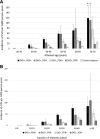The Association of Severe Diabetic Retinopathy With Cardiovascular Outcomes in Long-standing Type 1 Diabetes: A Longitudinal Follow-up
- PMID: 30257963
- PMCID: PMC6973548
- DOI: 10.2337/dc18-0476
The Association of Severe Diabetic Retinopathy With Cardiovascular Outcomes in Long-standing Type 1 Diabetes: A Longitudinal Follow-up
Abstract
Objective: It is well established that diabetic nephropathy increases the risk of cardiovascular disease (CVD), but how severe diabetic retinopathy (SDR) impacts this risk has yet to be determined.
Research design and methods: The cumulative incidence of various CVD events, including coronary heart disease (CHD), peripheral artery disease (PAD), and stroke, retrieved from registries, was evaluated in 1,683 individuals with at least a 30-year duration of type 1 diabetes drawn from the Finnish Diabetic Nephropathy Study (FinnDiane). The individuals were divided into four groups according to the presence of diabetic kidney disease (DKD) and/or SDR (+DKD/+SDR, +DKD/-SDR, -DKD/+SDR, and -DKD/-SDR) at baseline visit. Furthermore, age-specific incidences were compared with 4,016 control subjects without diabetes. SDR was defined as laser photocoagulation and DKD as estimated glomerular filtration rate <60 mL/min/1.73 m2.
Results: During 12,872 person-years of follow-up, 416 incident CVD events occurred. Even in the absence of DKD, SDR increased the risk of any CVD (hazard ratio 1.46 [95% CI 1.11-1.92]; P < 0.01), after adjustment for diabetes duration, age at diabetes onset, sex, smoking, blood pressure, waist-to-hip ratio, history of hypoglycemia, and serum lipids. In particular, SDR alone was associated with the risk of PAD (1.90 [1.13-3.17]; P < 0.05) and CHD (1.50 [1.09-2.07; P < 0.05) but not with any stroke. Moreover, DKD increased the CVD risk further (2.85 [2.13-3.81]; P < 0.001). However, the risk was above that of the control subjects without diabetes also in patients without microvascular complications, until the patients reached their seventies.
Conclusions: SDR alone, even without DKD, increases cardiovascular risk, particularly for PAD, independently of common cardiovascular risk factors in long-standing type 1 diabetes. More remains to be done to fully understand the link between SDR and CVD. This knowledge could help combat the enhanced cardiovascular risk beyond currently available regimens.
© 2018 by the American Diabetes Association.
Figures


Comment in
-
Comment on Pongrac Barlovic et al. The Association of Severe Diabetic Retinopathy With Cardiovascular Outcomes in Long-standing Type 1 Diabetes: A Longitudinal Follow-up. Diabetes Care 2018;41:2487-2494.Diabetes Care. 2019 Mar;42(3):e48. doi: 10.2337/dc18-2202. Diabetes Care. 2019. PMID: 30787063 No abstract available.
-
Response to Comment on Pongrac Barlovic et al. The Association of Severe Diabetic Retinopathy With Cardiovascular Outcomes in Long-standing Type 1 Diabetes: A Longitudinal Follow-up. Diabetes Care 2018;41:2487-2494.Diabetes Care. 2019 Mar;42(3):e49-e50. doi: 10.2337/dci18-0058. Diabetes Care. 2019. PMID: 30787064 No abstract available.
Similar articles
-
Differential Association of Microvascular Attributions With Cardiovascular Disease in Patients With Long Duration of Type 1 Diabetes.Diabetes Care. 2018 Apr;41(4):815-822. doi: 10.2337/dc17-2250. Epub 2018 Jan 31. Diabetes Care. 2018. PMID: 29386250 Free PMC article.
-
Association of Diabetic Retinopathy and Diabetic Kidney Disease With All-Cause and Cardiovascular Mortality in a Multiethnic Asian Population.JAMA Netw Open. 2019 Mar 1;2(3):e191540. doi: 10.1001/jamanetworkopen.2019.1540. JAMA Netw Open. 2019. PMID: 30924904 Free PMC article.
-
The Prognosis of Patients With Type 2 Diabetes and Nonalbuminuric Diabetic Kidney Disease Is Not Always Poor: Implication of the Effects of Coexisting Macrovascular Complications (JDDM 54).Diabetes Care. 2020 May;43(5):1102-1110. doi: 10.2337/dc19-2049. Epub 2020 Mar 6. Diabetes Care. 2020. PMID: 32144168
-
Cardiovascular risk in the young type 1 diabetes population with a low 10-year, but high lifetime risk of cardiovascular disease.Diabetes Obes Metab. 2013 Mar;15(3):198-203. doi: 10.1111/dom.12013. Epub 2012 Oct 24. Diabetes Obes Metab. 2013. PMID: 22998614 Review.
-
[Diseases and conditions associated with juvenile type 1 diabetes].Duodecim. 2004;120(9):1175-80. Duodecim. 2004. PMID: 15232861 Review. Finnish. No abstract available.
Cited by
-
Chronic ocular small vessel disease: An overview of diabetic retinopathy and its relationship with cardiovascular health.Am Heart J Plus. 2023 Feb 9;29:100270. doi: 10.1016/j.ahjo.2023.100270. eCollection 2023 May. Am Heart J Plus. 2023. PMID: 38510674 Free PMC article.
-
Dissecting the relationship between heart failure and diabetic retinopathy severity in patients with diabetes and chronic kidney disease: an observational cohort study.Sci Rep. 2025 Jul 8;15(1):24346. doi: 10.1038/s41598-025-04523-1. Sci Rep. 2025. PMID: 40624114 Free PMC article.
-
Associations of Microvascular Complications With the Risk of Cardiovascular Disease in Type 1 Diabetes.Diabetes Care. 2021 Jul;44(7):1499-1505. doi: 10.2337/dc20-3104. Epub 2021 May 12. Diabetes Care. 2021. PMID: 33980605 Free PMC article.
-
Same-Day Cancellation is Higher in Outpatient Pars Plana Vitrectomy for Proliferative Diabetic Retinopathy.Risk Manag Healthc Policy. 2022 Oct 20;15:1965-1974. doi: 10.2147/RMHP.S378510. eCollection 2022. Risk Manag Healthc Policy. 2022. PMID: 36299661 Free PMC article.
-
Microvascular complications burden (nephropathy, retinopathy and peripheral polyneuropathy) affects risk of major vascular events and all-cause mortality in type 1 diabetes: a 10-year follow-up study.Cardiovasc Diabetol. 2019 Nov 16;18(1):159. doi: 10.1186/s12933-019-0961-7. Cardiovasc Diabetol. 2019. PMID: 31733651 Free PMC article.
References
Publication types
MeSH terms
Grants and funding
LinkOut - more resources
Full Text Sources
Other Literature Sources
Medical
Miscellaneous

